Introduction
The State Legislature plays a central role in shaping laws that govern everyday life within a state. The law-making procedure in a state legislature follows a structured constitutional framework that ensures accountability, debate, and transparency. Although the Vidhan Sabha enjoys greater authority in the process, both Houses participate in states with a bicameral structure. The ultimate goal is to create laws that reflect public needs, administrative feasibility, and constitutional values.
Understanding this procedure is essential for students, policymakers, and UPSC aspirants because it forms the foundation of India’s federal legislative process.
Structure of the State Legislature
Most states in India follow a unicameral system, with only the Vidhan Sabha as the law-making body. A few states follow a bicameral system, where the Vidhan Parishad acts as the second chamber. Regardless of the structure, the core steps of law-making remain similar, though the involvement of the second chamber may extend the duration of the process.
The Governor also plays an important constitutional role because every bill requires assent before becoming law.
Types of Bills Introduced in State Legislature
The procedure depends on the type of bill. Ordinary Bills deal with general matters, Money Bills relate to taxation and expenditure, and Financial Bills deal with financial issues but are not classified strictly as Money Bills. Each type follows distinct rules, yet they all require legislative approval and the Governor’s assent.
Money Bills can originate only in the Vidhan Sabha, while Ordinary Bills may originate in either House in bicameral states.
Stages in Law-Making for Ordinary Bills
The process begins with drafting, followed by consideration and approval through several stages. A minister or a private member may introduce the bill. The bill then passes through three important readings.
The first reading involves introduction. The minister or member seeks permission to introduce the bill. Once the House grants permission, the bill is published and formally placed before the legislature.
The second reading forms the core of the law-making process. The House examines the principles and details, often referring the bill to a committee for deeper scrutiny. The bill may then return for clause-by-clause consideration, where members recommend amendments. This stage ensures that the bill is legally sound and administratively feasible.
The third reading focuses on final approval. Members debate the overall merit of the bill and vote on its passage. If the House passes the bill with a simple majority, it moves to the second chamber if the state has a bicameral system. In a unicameral state, the bill proceeds directly to the Governor.
Procedure in the Second House (If Applicable)
In states with a Legislative Council, the bill undergoes similar readings in the second chamber. The Council may approve the bill, reject it, amend it, or delay it for a limited time. If the Council rejects or delays the bill, the Vidhan Sabha can pass the bill again. In such cases, the Council must accept the bill without further delay. This structure ensures that the elected House retains ultimate authority.
For Money Bills, the Council’s powers remain narrow. It may offer recommendations but cannot amend or reject the bill. It must return the bill within fourteen days.
Money Bill Procedure
Money Bills occupy a special place in the legislative process because they relate to taxation and public spending. Only a minister may introduce a Money Bill, and that too only in the Vidhan Sabha. The Speaker of the Vidhan Sabha has final authority to certify whether a bill is a Money Bill.
Once the Sabha passes the Money Bill, it goes to the Council for recommendations. The Sabha may accept or reject these suggestions. The bill automatically becomes eligible for submission to the Governor when the fourteen-day period ends.
This special procedure keeps financial control in the hands of elected representatives.
Governor’s Role in the Law-Making Process
After a bill clears the legislature, it moves to the Governor for assent. The Governor may assent to the bill, withhold assent, return it for reconsideration, or reserve it for the President’s consideration. The Governor cannot return a Money Bill but may return an Ordinary Bill for reconsideration.
If the legislature passes the bill again, the Governor must give assent unless the bill has been reserved for the President. When a bill is reserved, the President may assent, withhold assent, or return the bill. After reconsideration, presidential assent becomes mandatory if the bill is passed again.
The Governor’s role adds an important layer of constitutional supervision.
Why the Procedure Matters
The law-making process ensures that laws do not emerge from haste or political impulse. It allows members to debate the intent, wording, and implications of a proposal. Committee scrutiny adds expert review. The involvement of two Houses, where applicable, deepens deliberation. The Governor and, in rare cases, the President introduce constitutional oversight.
This structured process protects democratic values and maintains a balance between governance and accountability. It also ensures that citizens receive well-framed, legally sound laws that stand the test of time.
Conclusion
The law-making procedure in the State Legislature reflects the foundational principles of Indian democracy. It ensures thoughtful deliberation, financial accountability, and constitutional supervision. Though the Vidhan Sabha remains the central authority in states, the Vidhan Parishad and the Governor play critical roles in refining legislation. By understanding each step of the process, one can appreciate the depth and complexity involved in shaping state laws.
For any specific query call at +91 – 8569843472








